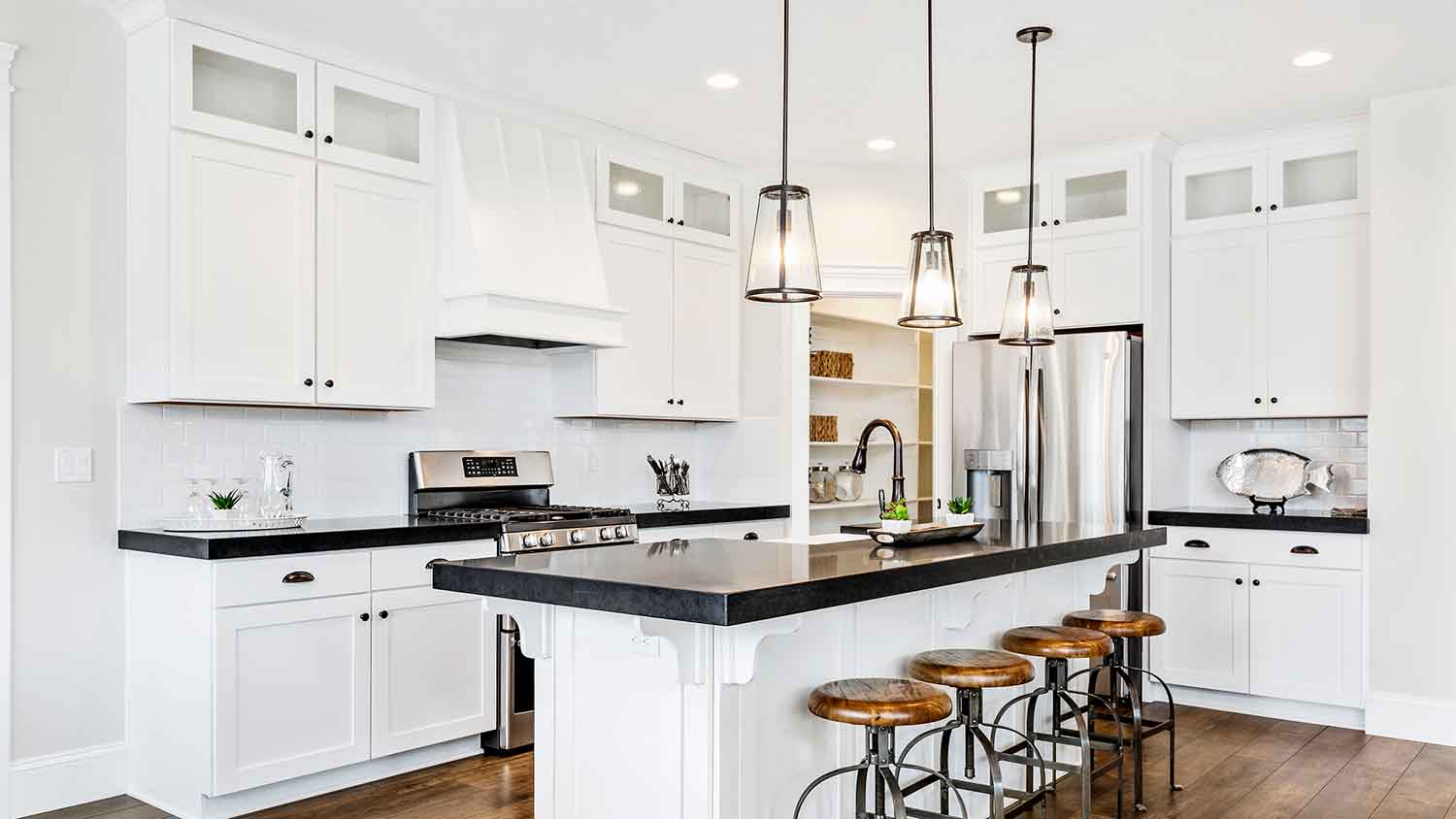
Discover how much under-cabinet lighting costs. Discover installation prices, key cost factors, and expert tips to save on your kitchen or workspace lighting project.
Explore the ins and outs of white vs. yellow light


White light has higher Kelvin (cooler) temperatures, usually around 5,000K to 6,500K.
Yellow light has lower Kelvin (warmer) temperatures from 2,700K to 3,500K.
White lights range from around $2 to $10 per bulb.
Yellow lights typically cost between $2 to $5 dollars per bulb.
Besides personal preference, there are some specific uses for white vs. yellow light. Picture white light as the poster child for modernity and clarity, while yellow light gives off warm and cozy vibes. Depending on the mood, ambiance, and energy efficiency you’re looking for, this guide is here to help you make thoughtful lighting choices tailored to your home's unique needs. Illuminate your space the way you want as you discover if white or yellow light is the perfect glow for your lifestyle.
White light, with its higher color temperature, is like the superhero of accurate color rendering. It’s perfect for spots where you need to nail the exact shade, like design studios. Yellow light, on the other hand, gives off warm, cozy vibes which are perfect for rooms where relaxation is key. Dive into more big differences between white and yellow light below.
| Feature | White Light | Yellow Light |
|---|---|---|
| Color temperature | 5,000 – 6,500K | 2,700 – 3,500K |
| Mood and ambiance | Bright, energizing | Warm, comforting |
| Sleep impact | Bad for sleep | Good for sleep |
| Applications | Workspace or kitchen | Bedroom, great room |
| Flicker | High flicker | Less flicker |
| Dimming | Lots of options | Limited range |
| Energy efficiency | High | Lower |
| Cost | $2 –$10 per bulb | $2 – $5 per bulb |
White light nails color accuracy, which is great for places where you need colors to pop. White light is also ideal for spaces where color accuracy matters, such as art studios or galleries. It enhances the vibrancy and true representation of colors in artwork and decorative elements. White light has higher Kelvin (cooler) temperatures, often around 5,000K to 6,500K, which can resemble natural daylight.
Yellow light, with its warm tones, can play with colors a bit, giving a cozy feel but only sometimes true to the original shades. For instance, it can cast a green hue over an area if the space has blue light. Yellow light has lower Kelvin (warmer) temperatures, typically between 2,700K and 3,500K.

Watch out, night owls! White light, especially in the evening, can disrupt your circadian rhythm. It's like a mini sunrise, telling your brain to stay awake. So, keep it dim when bedtime approaches. White light is more often used in areas where you need to see things clearly, such as task-oriented spaces. Since it can also resemble daylight, it’s good in spaces where you need to be alert and focused.
Yellow light creates a warmer and softer ambiance and is better suited for areas with a cozy and inviting atmosphere rather than those that need precision in showcasing colors. The warm tones of yellow light are also kinder to your sleep routine. They signal to your brain that it's time to chill, making it a friendlier option for cozy evenings and bedtime ambiance as it allows your eyes to rest and your body to calm down.
Some people may perceive flicker more easily with certain types of white light, especially in fluorescent or low-quality LED sources. This flicker can cause discomfort or fatigue over extended periods.
Generally, yellow light sources, like incandescent bulbs, have a smoother and less noticeable flicker, making them a preferable choice for individuals sensitive to flickering light.
Ready for a movie night? White light, especially in LED form, usually offers better dimming capabilities. It can smoothly transition from spotlight-bright to soft glow, giving you total control over the vibe.
While yellow light is excellent for creating a laid-back atmosphere, its dimming range might not be as extensive as white light.

Yellow light, with its warm and inviting glow, may not be as energy-efficient as its white counterpart, making it a preferred choice for settings where you need ambient lighting over a primary lighting source.
White light, particularly in advanced LED technology, boasts greater energy efficiency and reduces long-term electricity costs.
The cost of white and yellow lighting can vary based on several factors, including the type of bulbs, technology, and energy efficiency.
Traditional incandescent bulbs, which often emit a warmer yellow light, tend to be less expensive, typically costing between $2 to $5 per bulb. Alternatively, energy-efficient options like LED bulbs, which often emit white light, may have a higher initial cost, ranging from around $2 to $10 per bulb.
Check current prices and consider factors such as energy efficiency and lifespan when comparing the cost of yellow and white light bulbs. Prices can also vary based on geographic location and market conditions.
If you’re still unsure which to choose, don’t hesitate to contact a light fixture expert near you. They know how to pick the right light bulbs for your fixtures and create the ideal lighting your space is looking for.
365 Kool arrived earlier than expected and priced me out fairly. The technician even notified me of other potential issues. This company truly cares!
He requested I review his service, so I am following through. This week was the second service. I told him that our particular needs were that the trash cans in the living room, kitchen, and my bedroom be emptied. I explained what should go in recycling and which should go in garbage bin...
Bobby seemed like the nicest, friendliest guy in the world, and did manage to get our kitchen built and ready with the stress of COVID hanging over our heads (January-March 2020). But the second he got his final payment he disappeared off the face of the earth and has not responded to any...
Eddie and his assistant Ruben were so professional, I couldn't ask for more. They helped me located and understand my security light, my porch light, fixed the wiring problem in my kitchen, came up with a gameplan for the living room lighting, and for the door bell, all along explaining...
Star Light Construct is the best group of contractors I've ever worked with. They painted the apartment, stained the floors (and re-floored the closets) and did a bunch of carpentry work throughout the space. Unbelievably great service and excellent work. I will be rehiring them for the next...
I engaged Chris Petti of this company as my general contractor in 2015 to perform a major renovation for my apt that includes kitchen, roof, and bathrooms. It is an arrangement where I purchased most of the items (e.g., toilet, kitchen closet, lighting, tiles, etc.) I need. The contractor...
The clients wanted more light in their apartment, and Jason delivered. He knew just the right placement for the new fixtures, the correct bulbs for existing ones, and he had it all done on time for a reasonable cost. He was communicative, exceptionally professional, and obviously...
The service provided was outstanding. Nelson came out the same day. i called and started working and removing all the water. He was very professional and very knowledgeable about the process i had to go through, helped with my insurance claim and followed through by even helping me...
Steven exceeded all of my expectations. He was available for an estimate on the same day that I called him. When he arrived, he assessed the condition of the room, recommended the color that would match the rest of the apartment, and offered us a choice of two dates for him to do the work. He...
From average costs to expert advice, get all the answers you need to get your job done.

Discover how much under-cabinet lighting costs. Discover installation prices, key cost factors, and expert tips to save on your kitchen or workspace lighting project.

Get transparent light fixture repair cost info. Learn what impacts price, compare repair vs. replacement, and find ways to save.

Discover the cost to install recessed lighting. Discover how price factors, labor, and other considerations can help you save on your lighting project.

Ceiling lights come in a wide array of styles and functions. Use this guide to learn about the types of ceiling lights to find one that suits your space.

Discover how to hang string lights from any spot in your yard for an instant glow up that feels warm, cozy, and downright fun.

Life happens, and bulbs break! Learn how to remove a broken light bulb the safe, easy way with five proven methods in this guide.